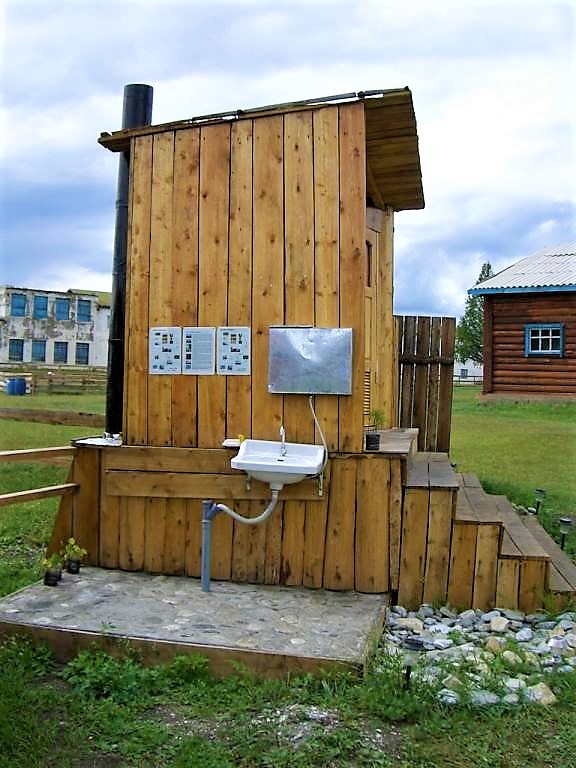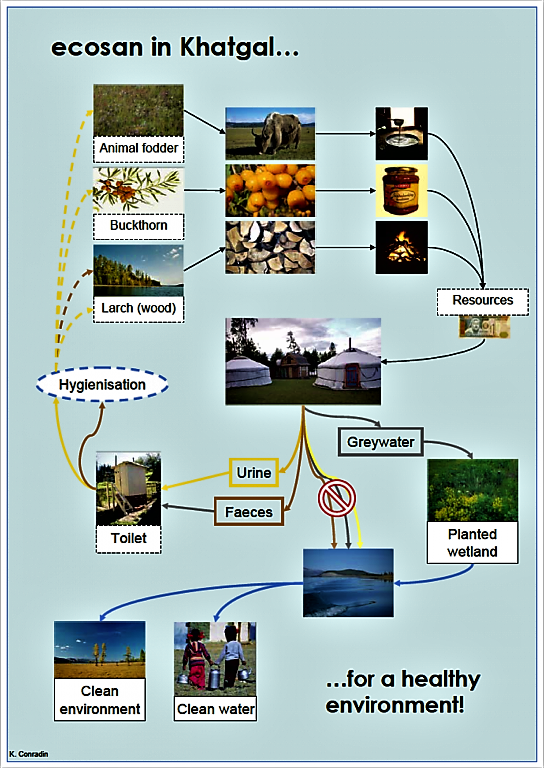Executive Summary
Creating appropriate and specific information materials for water and sanitation programmes is of key importance and a way to assure a strong and sustained impact and behavioural change in a given community or area. Effective information materials can awaken curiosity and interest in the subject matter. Awareness raising materials is an important way to reach a lot of people.
Why Is It Important to Develop Information Materials?
Basically used to enrich a horizontal learning process within the group or community, information materials are a way of sharing useful information in appropriate and interesting forms and on a timely basis to those people and groups who can make the best use of it. Information materials can raise awareness regarding the existence, nature, extent and severity of problems early on in the learning process and, at a later stage, can provide useful and necessary information on technical options and solutions, as well as critical information on construction and installation of selected solutions, as well as recommendations on the appropriate use, operation and maintenance.
If not provided to the targeted audience at the right time, external information can short-circuit the learning process of the group and hinder the expected program results. As different people understand different things, to have access to sequential and orderly information is important. Whereas some information materials (e.g. poster and flyer) might be designed for general consumption of a wide community audience, other materials with more detailed technical information might be directed to a specific group (e.g. water and sanitation committee or parent-teachers association) or even individuals with specific responsibilities (e.g. masons or plumbers responsible for installation and maintenance). In this way, the people who receive the information might apply it directly or, in turn, disseminate and transmit it to others, outlining steps to teach and train others.

Who Should Be Involved in Creating Information Materials?
Creating effective information materials is generally a multidisciplinary team process, as it requires diverse skills and experience, including a clear grasp of both social and technical issues. In addition, such an undertaking also requires one person who can manage and maintain the broad vision of both text and graphic materials, and how to merge them. Much of the process in developing materials has to do with coordinating the different persons and perspectives involved in the process (writer(s), designer, artist, and printer). And, of course, indirectly, the community (the users of the information) must be at the centre of the process — it is their need, their implicit and explicit demand for relevant information, which must be generated by a participatory learner-centred development process.
Characteristics of Information Materials
Once an initial problem identification and information needs-assessment has been carried out, planning the production of material required for the program can begin to take place. Both the written and visual language of the material should be carefully crafted to reflect the context of the users. For graphic purposes, it is critical to carefully consider the local culture and regional characteristics of where the material is going to be used, including dress codes/styles, landscape and architectural typology.

Depending on the target audience, be it for adults or children, key communication elements — such as colloquial vs. technical language — should be identified. In areas where people do not necessarily know how to read and write, it will be necessary to prepare information and training materials that are suitable for the language and cultural context, relying a lot more on clear illustrations. Peoples´ levels of visual literacy can also vary, often depending on their previous exposure to visual communication media. For those less accustomed to looking at visual images, make sure that they will be able to read the images well. But in order to be able to apply and impact of the materials, it might also be useful to develop the information not limited to a very specific area by identifying images and “types” that are sufficiently universal to be used in a number of similar areas — i.e. rural, urban, indigenous, etc.
Another consideration has to do with accompanying the material with a section or guidelines on how to use it — suggested target audience, how/when/where to display or distribute, etc. A distinction should initially be made if the information will be geared toward more technical people, like for example, people who would have clear spelled-out responsibilities related to the building, operation and maintenance of water and sanitation systems. Although not commonly taken into consideration, it might be useful to make some sort of provision for the conservation and monitoring of the useful life of the materials. For example, a simple feedback form (possibly with an email or internet address) can facilitate feedback for long-term evaluation and budgeting purposes.
For budgetary purposes, also consider the print run (amount of printed material, including formats, colours, quality of printing, etc.).Will the material be for sale, distributed freely, easily reproduced at a local level? If involved in a local programme, screen/stencil printing might be a way to get local people involved, with a view that the materials could at least be designed with the potential of going to scale.
With Variations, a Typical Materials Development Process Will Have The Following Stages:
- Developing the concept, timeline and budget for the whole project
- Identifying the writer(s) for the text and artist(s) and/or graphic designers for the drawings, illustrations or other graphics
- Deciding on the format and digitalizing first concept with text (getting the messages right) and graphics
- Sharing drafts with your work group
- Field-testing the materials to find out how potential users interpret the messages and visuals
- Incorporating group’s and users’ feedback into the final draft including graphic design
- Having the revised proofs, final print and distribution
Different Materials, Different Media
Posters, stickers, banners: with striking visual images and provocative one-way messages, these materials can be publicly displayed indoors or outdoors to wide audiences.
Factsheets, booklets, newsletter, guidelines and manuals: although time-consuming to produce and distribute, using the written word and pictures helps to communicate in a long-lasting form.
Mass media — newspapers, radio, videos and TV and internet: make use of the mass media to publicise information, opinions and concerns to a larger audience and to influence people in power and decision-making positions. Mass media reaches very large audiences and is an efficient means to widely publish. Today the internet is used in participatory processes and it helps to link participants from different regions or countries, share information or distribute educational material (PRACTICAL ACTION 2007).
Subscribe here to the new Sanitation and Water Entrepreneurship Pact (SWEP) newsletter. SWEP is a network of organizations joining hands to help entrepreneurs design and develop lasting water and sanitation businesses.
Information Material and Participatory Materials and Approaches
It is useful to distinguish between purely didactic (one-way) information materials and materials that are specifically designed to stimulate participatory horizontal learning processes. These latter tools are generally free of fixed messages and rather support group reflection, analysis and planning, and the development of organisation, negotiation and problem solving skills. They help in establishing a trust relationship. Expressive materials such as photographs help support description of a situation through participatory sessions. These types of tools are commonly used to address problems with creative solutions.
As mentioned above, information materials are most effective when they are designed to support and harmonise with (rather than a substitute for) true participatory development processes.
Participatory approaches cover a wide range of tools and methodologies which all have one common feature: they all attempt to actually involve "the public," and give them both a stake in the outcome of the process and power to determine its direction. Most participatory approaches work with group of people, for example, existing community groups, school classes, groups of teachers or other groups. An example of a program which is now applied in several African countries is participatory hygiene and sanitation transformation (PHAST). PHAST emphasises empowerment of members to assess their own knowledge base, investigate the local environment and visualise a future scenario for their own community (SCHAAP & VAN STEENBERGEN 2001).
Information material can be used in relation to any topic and any issue. As noted above, it is important that it meets the requirements of the target population, i.e. that pictures are used when dealing with illiterate segments of the population or children, that dress codes, architectural style, ethnic idiosyncrasies, etc. are recognised, and that the information content is adapted to the needs of the target population. Appropriate information material can be an important contribution to accompany many social or technical interventions.
Ideas for Water Awareness Campaigns
This document includes a section for advocacy, presenting an overview of many ideas and initiatives with emphasis on practical suggestions and clues. It is not a guidebook for planning your advocacy work but it might be a great knowledge source and starting point for your activities.
SCHAAP, W. STEENBERGEN, F. van (2001): Ideas for Water Awareness Campaigns. Stockholm: The Global Water Partnership URL [Accessed: 24.06.2019]PHAST Step-by-Step Guide: A Participatory Approach for the Control of Diarrhoeal Disease
This guide provides a detailed description of the approach and his related core elements. The seven-step approach guides the reader and user through all important aspects of the PHAST planning process. Furthermore, important participatory methods for planning activities are described and training materials are included.
WHO (1998): PHAST Step-by-Step Guide: A Participatory Approach for the Control of Diarrhoeal Disease. Geneva: World Health Organisation WHO URL [Accessed: 26.04.2019]Water for Life - Community water security
The Schumacher Centre for Technology and Development
Ideas for Water Awareness Campaigns
This document includes a section for advocacy, presenting an overview of many ideas and initiatives with emphasis on practical suggestions and clues. It is not a guidebook for planning your advocacy work but it might be a great knowledge source and starting point for your activities.
SCHAAP, W. STEENBERGEN, F. van (2001): Ideas for Water Awareness Campaigns. Stockholm: The Global Water Partnership URL [Accessed: 24.06.2019]CHAST “Children’s Hygiene And Sanitation Training” In Somalia
This paper provides a very good understanding of the CHAST approach with its development and tools.
DE VREEDE, E. (2004): CHAST “Children’s Hygiene And Sanitation Training” In Somalia. The Netherlands: School Sanitation and Hygiene Education Symposium URL [Accessed: 26.04.2019]PHAST Step-by-Step Guide: A Participatory Approach for the Control of Diarrhoeal Disease
This guide provides a detailed description of the approach and his related core elements. The seven-step approach guides the reader and user through all important aspects of the PHAST planning process. Furthermore, important participatory methods for planning activities are described and training materials are included.
WHO (1998): PHAST Step-by-Step Guide: A Participatory Approach for the Control of Diarrhoeal Disease. Geneva: World Health Organisation WHO URL [Accessed: 26.04.2019]Guía para elaboración de material educativo en comunidades indígenas
A guidebook on how to create education material for indigenous communities (in Spanish).
PROYECTO PARA EL MEJORAMIENTO DE LAS COMUIDADES INDIGENAS (2003): Guía para elaboración de material educativo en comunidades indígenas. URL [Accessed: 22.04.2012]Improving water, sanitation and hygiene poster
Health risks around the water cycle
Project WET
Project WET (Water Education for Teachers) is a non-profit water education program that prepares curricula and materials on various water topics and devotes much attention to training teachers how to use them. The Project WET curriculum and activity guide is available to all formal and informal educators. The program started in the USA but now there are internationally sponsored Project WET programs together with other organizations.
International Water and Sanitation Centre (IRC)
Web page of the International Water and Sanitation Centre (IRC) with several publications on water supply systems operation and maintenance.
Practical Action
This site contains brief factsheets on a broad range of information technologies for information and communication, such as community radio, newsletters and booklets, posters etc.
Educating Young People About Water (EYPAW)
A site containing more than 150 curricula to educate young people about water issues (English) - ranging from acid rain to wise water use.

